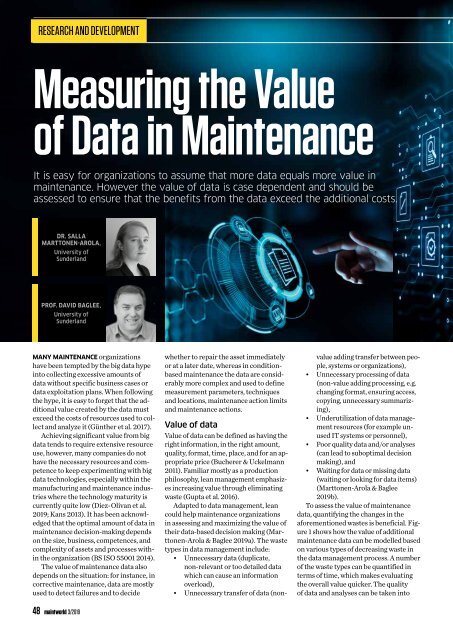Maintworld 3/2019
How Digital Twins Can Accelerate Your Digital Transformation // The Art of Reliability (and Performance) Improvement // 10 Basics to Improve Maintenance in Your Organisation
How Digital Twins Can Accelerate Your Digital Transformation // The Art of Reliability (and Performance) Improvement // 10 Basics to Improve Maintenance in Your Organisation
Create successful ePaper yourself
Turn your PDF publications into a flip-book with our unique Google optimized e-Paper software.
RESEARCH AND DEVELOPMENT<br />
Measuring the Value<br />
of Data in Maintenance<br />
It is easy for organizations to assume that more data equals more value in<br />
maintenance. However the value of data is case dependent and should be<br />
assessed to ensure that the benefits from the data exceed the additional costs.<br />
DR. SALLA<br />
MARTTONEN-AROLA,<br />
University of<br />
Sunderland<br />
PROF. DAVID BAGLEE,<br />
University of<br />
Sunderland<br />
MANY MAINTENANCE organizations<br />
have been tempted by the big data hype<br />
into collecting excessive amounts of<br />
data without specific business cases or<br />
data exploitation plans. When following<br />
the hype, it is easy to forget that the additional<br />
value created by the data must<br />
exceed the costs of resources used to collect<br />
and analyze it (Günther et al. 2017).<br />
Achieving significant value from big<br />
data tends to require extensive resource<br />
use, however, many companies do not<br />
have the necessary resources and competence<br />
to keep experimenting with big<br />
data technologies, especially within the<br />
manufacturing and maintenance industries<br />
where the technology maturity is<br />
currently quite low (Diez-Olivan et al.<br />
<strong>2019</strong>; Kans 2013). It has been acknowledged<br />
that the optimal amount of data in<br />
maintenance decision-making depends<br />
on the size, business, competences, and<br />
complexity of assets and processes within<br />
the organization (BS ISO 55001 2014).<br />
The value of maintenance data also<br />
depends on the situation: for instance, in<br />
corrective maintenance, data are mostly<br />
used to detect failures and to decide<br />
whether to repair the asset immediately<br />
or at a later date, whereas in conditionbased<br />
maintenance the data are considerably<br />
more complex and used to define<br />
measurement parameters, techniques<br />
and locations, maintenance action limits<br />
and maintenance actions.<br />
Value of data<br />
Value of data can be defined as having the<br />
right information, in the right amount,<br />
quality, format, time, place, and for an appropriate<br />
price (Bucherer & Uckelmann<br />
2011). Familiar mostly as a production<br />
philosophy, lean management emphasizes<br />
increasing value through eliminating<br />
waste (Gupta et al. 2016).<br />
Adapted to data management, lean<br />
could help maintenance organizations<br />
in assessing and maximizing the value of<br />
their data-based decision making (Marttonen-Arola<br />
& Baglee <strong>2019</strong>a). The waste<br />
types in data management include:<br />
• Unnecessary data (duplicate,<br />
non-relevant or too detailed data<br />
which can cause an information<br />
overload),<br />
• Unnecessary transfer of data (nonvalue<br />
adding transfer between people,<br />
systems or organizations),<br />
• Unnecessary processing of data<br />
(non-value adding processing, e.g.<br />
changing format, ensuring access,<br />
copying, unnecessary summarizing),<br />
• Underutilization of data management<br />
resources (for example unused<br />
IT systems or personnel),<br />
• Poor quality data and/or analyses<br />
(can lead to suboptimal decision<br />
making), and<br />
• Waiting for data or missing data<br />
(waiting or looking for data items)<br />
(Marttonen-Arola & Baglee<br />
<strong>2019</strong>b).<br />
To assess the value of maintenance<br />
data, quantifying the changes in the<br />
aforementioned wastes is beneficial. Figure<br />
1 shows how the value of additional<br />
maintenance data can be modelled based<br />
on various types of decreasing waste in<br />
the data management process. A number<br />
of the waste types can be quantified in<br />
terms of time, which makes evaluating<br />
the overall value quicker. The quality<br />
of data and analyses can be taken into<br />
48 maintworld 3/<strong>2019</strong>

















